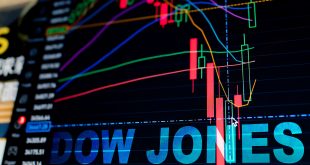From early 2025 to April 3, the U.S. stock market has navigated a turbulent phase marked by sharp volatility and liquidity declines, driven by factors like inflation, trade wars, and quantitative tightening, with examples like Gensol Engineering underscoring pressures on individual firms. For investors, this period demands flexible strategies to overcome challenges and seize opportunities amid this market storm.
Since the beginning of 2025, the U.S. stock market has witnessed dramatic developments that have captured the attention of investors and analysts alike. With sharp fluctuations in stock prices and a notable draining of liquidity during certain periods, it has become essential to understand the dynamics driving this massive market, which stands as one of the world’s most critical economic indicators. It is useful to understand what has transpired in the U.S. stock market from January 1, 2025, to today, April 3, 2025, with a focus on the phenomenon of liquidity evaporation and the reasons behind stock price volatility.
Overview of Market Performance Since Early 2025
The U.S. stock market kicked off 2025 with relatively optimistic expectations, bolstered by a gradual economic recovery following years of rebounding from the COVID-19 pandemic’s fallout, alongside a surge in technological innovation, particularly in artificial intelligence. However, this optimism was short-lived as the markets encountered mounting pressures that impacted major indices such as the Dow Jones, S&P 500, and Nasdaq. According to observers, the S&P 500 declined by approximately 3.4% from the start of the year through mid-March 2025, reflecting a challenging start compared to the robust gains of 2024, with concerns over trade wars contributing to liquidity drainage and heightened volatility as the first quarter drew to a close.
In the initial weeks of the year, markets were propelled by positive momentum from major tech firms like Nvidia and Microsoft, but this momentum dissipated as new factors eroded confidence. By early April, it became evident that the market was grappling with recurring volatility and a decline in liquidity, raising fears of a deeper correction. According to prominent economists, the Federal Reserve’s continuation of quantitative tightening (QT) for longer than anticipated added an extra layer of tension on Wall Street, where it had been expected to conclude by the end of 2024, yet signs point to its persistence into 2025.
Liquidity Drain: What’s Happening?
Liquidity, defined as the ease of buying or selling assets without significantly affecting their prices, is a vital component of any financial market’s stability. Since the start of 2025, institutional investors and fund managers have noted a significant reduction in liquidity in the U.S. stock market, particularly in individual stocks and futures tied to the S&P 500. According to observers, liquidity is “drying up” noticeably due to escalating concerns over trade wars, leading to wider bid-ask spreads and reduced trading volumes. Prominent economists have added that the Federal Reserve continues to drain liquidity through quantitative tightening, allowing up to $25 billion in Treasury securities and $35 billion in mortgage-backed securities to mature monthly without reinvestment, shrinking banking system reserves and intensifying pressure on markets.
In February 2025, data indicated that liquidity in S&P 500 futures hit its lowest level in two years. According to observers, this decline worsened in March amid growing fears of tariffs, while prominent economists noted that the Federal Reserve’s increased use of overnight reverse repo facilities signals a tightening of liquidity, raising concerns that it may be draining more than necessary. For instance, trading approximately $3 million in futures contracts has become costlier compared to the average of previous years, reflecting a “liquidity drought.”
This situation was particularly pronounced in individual stocks outside the realm of giants like Apple and Amazon, where traders struggled to find sufficient liquidity. According to observers, promoters of India’s Gensol Engineering were forced to sell a 2.37% stake (9 million shares) to secure liquidity, resulting in a 4% drop in the company’s shares—a pattern that could apply to U.S. firms facing similar pressures.
Reasons Behind Stock Price Volatility
The stock price volatility from early 2025 to April 3 can be attributed to a mix of economic, political, and market-driven factors. Let’s examine the most prominent ones:
Rising Interest Rates and Inflation:
Since mid-2024, the Federal Reserve began signaling continued monetary tightening to combat persistent inflation. By January 2025, elevated interest rates negatively impacted companies reliant on borrowing, leading to lower valuations in the tech sector and increased volatility.
Recession Fears: In March 2025, data revealed a significant drop in U.S. consumer confidence, the largest since the 2021 COVID-19 crisis. According to observers, this decline heightened fears of a potential stagflationary recession, amplifying market pessimism.
Trade Wars and Geopolitical Tensions: Trade tensions between the U.S. and China escalated in 2025 with new tariffs on tech imports. According to observers, these tariffs eroded confidence and drained liquidity, causing significant volatility in stocks like Tesla and Nvidia.
Algorithmic Trading and Exacerbated Volatility:
As volatility surged, high-frequency trading algorithms became more active, amplifying price movements. According to observers, these algorithms worsened the liquidity decline, making the market less predictable.
Oil Price Fluctuations: Oil prices saw notable swings in Q1 2025 due to Middle East tensions, impacting the energy sector and leading to mixed stock performance.
Federal Reserve Policy and Quantitative Tightening: According to prominent economists, the Federal Reserve’s prolonged quantitative tightening has sparked Wall Street’s unease. Despite expectations of rate cuts to a 4.5%-4.75% range in 2025, shrinking its $7 trillion balance sheet reduced bank reserves to about $3.2 trillion, raising questions about the minimum needed for market stability.
Liquidity Pressures on Individual Companies: According to observers, liquidity pressures at Gensol Engineering led promoters to sell stakes, reflecting challenges that U.S. companies might similarly face.
Impact on Investors
For investors, this period has been fraught with challenges.
According to observers, rising hedging costs have made portfolio protection more difficult, while prominent economists note that ongoing quantitative tightening fuels fears of a liquidity shortage, prompting some to turn to exchange-traded funds (ETFs). The Gensol Engineering case highlights how selling shares to secure liquidity can exert downward pressure on prices.
Near-Term Outlook
As mid-April 2025 approaches, the outlook remains mixed. According to observers, persistent “trade war anxiety” could further strain liquidity, while prominent economists suggest that quantitative tightening may be complicated by issues like the U.S. debt ceiling, with the Treasury potentially drawing down its general account if Congress fails to raise the limit by January 2025. If trade tensions ease or recession fears subside, liquidity might temporarily improve, but volatility could persist due to elevated valuations and interest rate pressures.

 Noor Trends News, Technical Analysis, Educational Tools and Recommendations
Noor Trends News, Technical Analysis, Educational Tools and Recommendations




